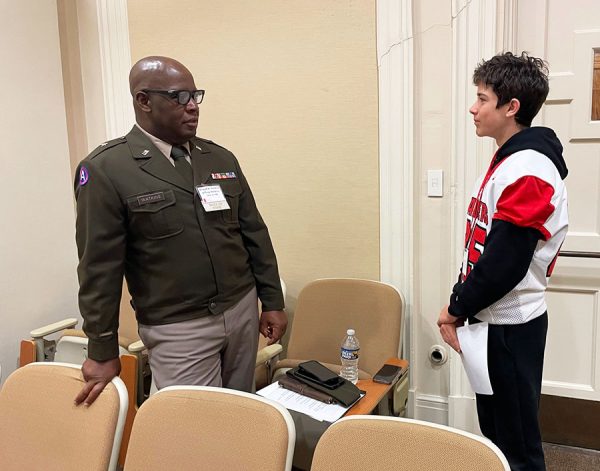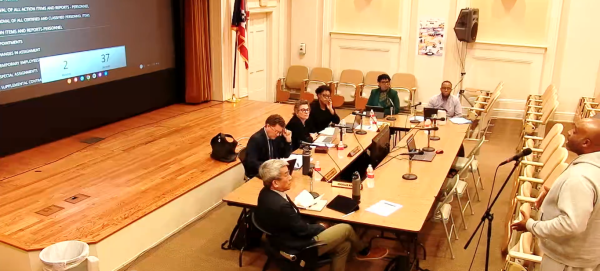New Plan Aims to Make Those Middle School Years Less Difficult
Changing nine 39-minute periods to eight 50-minute periods, new schedule eliminates Cycle class, changes structure of art programs
When the district hired David Glasner as Shaker Heights Middle School’s new principal, Assistant Superintendent of Secondary Instruction Marla Robinson singled out the school’s 39-minute class periods as a primary concern.
“That’s something we’ll be talking about,” said Robinson in June 2014. “That’s not enough time for teachers to teach sufficiently.”
Now, all those talks have come to fruition, with the middle school’s plan to alter its bell schedule to increase instructional time.
The current bell schedule at the middle school comprises nine 39-minute-long periods. The proposed changes will create eight 50-minute-long periods, accomplished by altering the school’s curriculum.
“I think that next year’s middle school program and schedule really meets the needs of all of our students,” said Glasner. “It is an exciting opportunity for the middle school — we’ve created a schedule that allows students to deeply engage in skill development and rigorous learning and Common Core work within the IB framework.”
“I think this schedule works for all different types of students in many ways,” Glasner said.
Eighth grader Eliana Sosin said that the current 39-minute class periods affect instruction. “The teachers are always rushing,” she said.
Band Boosters co-president Jennifer Kidd believes that a prolonged class period is necessary.
“It’s a great thing to have longer periods during the school day so that kids in band will have more time actually in band. That’s going to be, I think, a really great thing,” Kidd said.
Middle school art teacher Adrienne Richard-Casselberry agreed. “Especially with the requirements of IB, having the class period be longer — that’s golden,” she said. “We’ll be able to really do a lot with that amount of time. It’s exciting. We can really develop skills, develop our IB lessons, and the students can really delve into the curriculum.”
A previous draft of the schedule, proposed Nov. 9, suggested students would have the option of taking one full year of music, one full year of visual art or one semester of each. Students who opted to take one semester of each would have had music first semester and visual arts second semester.
Band Boosters Presidents Kidd and Irene Meyerhoefer expressed their concerns for the integrity of Shaker’s music programs in an email to the school board at that time.
“We are asking you to leave the 9 period day intact at the Middle School to allow students to continue to develop musically as well as choose to take an art class or a second language,” wrote Meyerhoefer and Kidd in the email. “We believe that this is crucial to improving our students’ musical abilities that carry over into the High School programs.”
“The Shaker community (residents, students, alumni, etc.) cares about its music and art programs,” wrote Meyerhoefer and Kidd. “You say Shaker Heights Schools provide ‘A World of Opportunities.’ The Shaker music and art programs are a big part of what makes Shaker attractive to prospective residents and keeps alumni coming back.”
The school board recognized the band boosters’, parents’ and community members’ concerns and altered the proposed schedule, giving students the option of taking one year of music, one year of visual art or one year of both.
“If they had kept music one semester on and one semester off, it would have definitely negatively affected the quality of the band program,” said Meyerhoefer. “There are certain people who look forward to the band program, and we were disappointed that it would have been affected.”
Kidd said, “We really thought [the proposal] was not an option, that it was going to end up being very disruptive and that it was really not workable.”
The two still have concerns, however, about incoming students’ participation in music programs
“It might reduce the number of kids who go into [band],” Meyerhoefer said.
Kidd agreed. “I think it will improve the quality of the kids who are in band, but it’s going to decrease the number of kids who play in the band,” she said.
Richard-Casselberry believes that giving middle schoolers the option whether or not to take art is not the best choice. “The one thing that Shaker has been able to provide that has been really strong is that we support the arts and having the kids have to choose between [visual arts and music] at this level is unfortunate,” she said. “The middle school time is really a time to explore. They’re still developing. They don’t really know what they want.”
Students who opt to take one year of both music and art will take an extended-day visual arts class four days per week during Raider Time, previously known as conference period, from 3-3:50 p.m.
“Raider Time is still something that we’re working on solidifying exactly what it will look like next year,” said Glasner. “I will say that we know from the feedback we’ve gotten from students, staff and community members that the way conferences are currently scheduled is effective for some of our students and some of our teachers. We can strengthen it, and that’s our goal. We want to make it more effective for more students and for more teachers.”
“If there’s a lot of people in the conference, then the teacher only gets a few minutes with you if you need to get something accomplished,” eighth grader Ava Edelman said. “You don’t get as much time as you would hope to get.”
Program Planning Committee member Eric Siler said, “I see a lot more flexibility with [Raider Time] and a greater way for students to extend or understand their academics and extracurricular activities.”
With the changes, Physical Education will take place five days a week for one semester. Students currently have three quarters of PE and one quarter designated for a health course during their gym period, with specific health teachers. With the proposed schedule, however, health will become part of PE and current PE teachers will teach the health material.
PE department chairman and Program Planning Committee member Timothy Richards expressed concern that blending PE and health curricula will cause a loss of health and PE teaching positions. “We’re getting hammered pretty bad. We’re looking at losing three of our seven teachers, so it’s hit home pretty close,” he said.“It’s going to be very hard to maintain the quality of what we consider an excellent health program,” Richards said.

The changes will affect long-standing curricula. Under the proposed bell schedule, traditional, quarter-long Cycle classes such as woodshop and cooking will no longer exist. Instead, middle schoolers will take a STEM-aligned IB Design following the same schedule as PE, occurring five days a week for one semester.
“I would expect elements of many of our current Cycle classes to be integrated into the Design curriculum moving forward,” however, Glasner said.
Tracey Warren, who teaches Design Product 8 this year, explained that because her class will now be a semester long rather than a quarter, “I’m looking forward to having my students for 18 weeks.”
Warren said that the extended class period will give her students an “opportunity to elaborate and expand on our units” and “time for a more global view of the subject.”
“I really believe that the Design class is going to be a centerpiece of our school moving forward. It is a class that will prepare our students for life in the 21st century, to be problem solvers, to collaborate, to be innovative, to use technology, to complete tasks and solve problems,” said Glasner. “Design course will rest on the IB design cycle. The design cycle requires students to identify a problem, investigate and research solutions to those problems. We’re infusing science technology, engineering and mathematics into that cycle.”
Edelman wants Cycle classes to be “something more interactive,” and “more hands-on, not just researching different things and sitting at a computer and doing math programs.”
The proposed changes also eliminate most study halls. Currently, students have one period broken into two 21-minute halves for lunch and a study hall. With the new schedule, students will have a 25-minute lunch period with no study hall.
Glasner said, “There may be some specific cases where study halls might exist. But certainly lunch study halls will not exist anymore, and the majority of other study halls won’t either.”
However, the middle school may adopt lunch clubs next year, which are currently active at Woodbury. Lunch clubs are used for club meetings during the day rather than after school, allowing students to eat in smaller groups.
“[Lunch clubs] may take more form of a lunch bunch here. It doesn’t necessarily have to be a specific club. We want to give students the opportunity to eat in smaller groups, if they would like,” Glasner said.
Middle school students can still take two world languages. Incoming middle school students who opt to take two world languages will be required to take PE and design during Raider Time.
There are currently 18 seventh graders enrolled in two world languages. This group of students will be “grandfathered” for the 2015-2016 school year and receive an optional exemption from PE and design, according to Glasner. This exemption will not exist for rising seventh graders.
The structure of advanced math classes will also change. “Highly advanced middle school students who meet the criteria for the 9 Math Honors class will still be able to take the class,” said Glasner. “However, we will be offering the class at the middle school next year so that the cohort of students will no longer have to travel to the high school.”
When the Program Planning Committee began discussing possible schedules for 2015-2016 block scheduling and an extended nine-period day were considered.
“Initially, actually when we started this process back in November, if you were to ask me to place a bet on which is the result we would end up with, I would have said hands down it’s going to be the block option,” Glasner said.
The committee eventually decided this option would not fit the middle school. “When we put pen to paper and tried to figure out how block schedule would work, we came across really insurmountable, logistical and staffing challenges here at the middle school,” said Glasner. “It requires a different staff set up and a different school set up then we already have.”
“We came to a point where as hard as we tried, we couldn’t overcome that. Secondly, we did research on block scheduling, and it requires faculty to be trained in a whole different way, a whole different approach to instruction, and we learned in our research that is a hard change to make in a short amount of time,” Glasner said.
An extended nine-period day would prolong the school day until 3:45 p.m., posing challenges for Raider Time.
“We knew there would be parents who would have a real issue with their students being required to stay that long all the time. Secondly, it’s really important to have a teacher meeting time, and we have that built into our schedule now,” Glasner said.
Richards explained that in December, the faculty submitted an alternative proposal that preserved the number of periods, but increased them from 39 minutes to 46 minutes.
“The administration insists that [the periods] have to be 50 minutes. We feel this is a financial move because they’re cutting out a whole period and that reduces the number of required teachers,” said Richards. “This has really hurt faculty morale, and we’re extremely concerned about all the unanswered questions for next year.”
Glasner, however, emphasized teachers’ role in creating the new procedure. He sees the new bell schedule as a positive change.
“I really want to reiterate that this schedule would not be possible without the feedback from so many of our community members and our stakeholders and our teachers and our students. We made many revisions and changes along the way thanks to the ideas and input we received,” said Glasner. “I really want to thank the Shaker community and the school for their passion about this, their interest in their children’s education and the support of the work we do here.”




